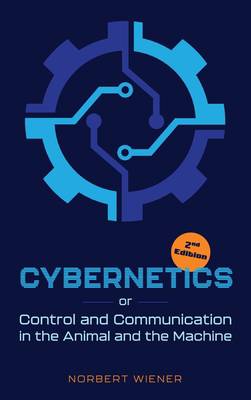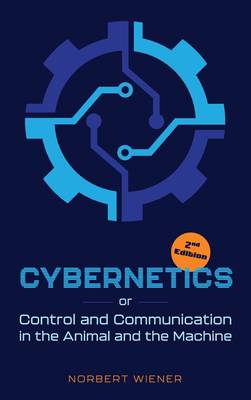
- Retrait gratuit dans votre magasin Club
- 7.000.000 titres dans notre catalogue
- Payer en toute sécurité
- Toujours un magasin près de chez vous
- Retrait gratuit dans votre magasin Club
- 7.000.0000 titres dans notre catalogue
- Payer en toute sécurité
- Toujours un magasin près de chez vous
Cybernetics, Second Edition
or Control and Communication in the Animal and the Machine
Norbert WienerDescription
Cybernetics or Control and Communication in the Animal and the Machine (Reprint of 1961 Second Edition) by Norbert Wiener is a seminal work that had long-ranging implications for the fields of computers, automation, electrical engineering, neuroscience, and communications.
Author Norbert Wiener (b. 1894, d. 1964) was a mathematician and philosopher, as well as a long-term professor of mathematics at the Massachusetts Institute of Technology (MIT). A child prodigy, Wiener graduated from high school at just 11 years old, and completed his BA in mathematics from Tufts University at the age of 14. By age 19, he had received his Ph.D from Harvard for a dissertation on mathematical logic.
While he was later a pacifist, Wiener contributed to the war efforts in both world wars, working on ballistics during World War I and anti-aircraft guns during World War II. By the late 1940s, he had grown concerned with the militarization of science, and stopped contributing to any military projects or taking government funding.
Wiener taught philosophy at Harvard during his early career, but was unable to secure a permanent teaching position-a fact he attributed to anti-Semitism, as the son of Jewish immigrants. After World War I, he was hired at MIT, where he would teach for the rest of his career.
In addition to teaching, Wiener conducted research in cognitive science and developed theories in cybernetics, computing, and automation. He also wrote many books and articles on these topics, as well as two autobiographical works.
Cybernetics or Control and Communication in the Animal and the Machine is one of Wiener's best-known works. Cybernetics refers to the science of control systems and communications in both machines and living beings. This book demonstrates the first public use of the term and describes the way self-regulating mechanisms (including the human brain) function through the receipt, processing, and use of external feedback.
This interdisciplinary work is the result of years of discussions with medical scientists, physicians, mathematicians, and physicists, giving it a wide range of influences both on the book's concepts and on the fields that it impacted. The book has been foundational for research into computing, electronic engineering, automation, telecommunications, and neuroscience.
At the core of cybernetics are feedback loops, the inflow of information and subsequent response. Both philosophical and technical, the book presents "noise" as the ultimate force that prevents equilibrium. And for the human being, mass media is the greatest source of that noise. Prescient, for a book written decades before personal computers, the internet, and smartphones.
A surprise bestseller, Cybernetics was read far beyond its intended technical audience. The book's popularity led Wiener to write a follow-up work further exploring the social and psychological implications of cybernetics called The Human Use of Human Beings.
Cybernetics also inspired a whole field of later writing, including the well-known self-development book Psycho-Cybernetics by Maxwell Maltz. This book draws heavily on Wiener's earlier work, and has been cited by self-help experts including Zig Ziglar and Tony Robbins as being a major influence on their techniques.
Spécifications
Parties prenantes
- Auteur(s) :
- Editeur:
Contenu
- Nombre de pages :
- 210
- Langue:
- Anglais
Caractéristiques
- EAN:
- 9781684931156
- Date de parution :
- 24-01-23
- Format:
- Livre relié
- Format numérique:
- Genaaid
- Dimensions :
- 152 mm x 229 mm
- Poids :
- 480 g

Les avis
Nous publions uniquement les avis qui respectent les conditions requises. Consultez nos conditions pour les avis.






